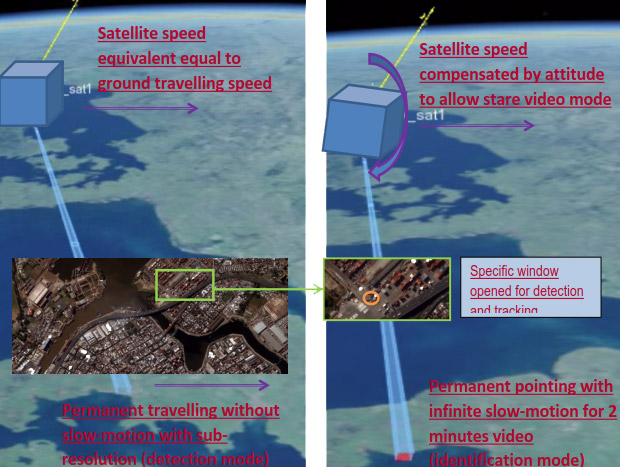VIDEO instrument mission overall principle
VIDEO instrument main goal is to perform video acquisition on small satellite.
The principle described here after are given for example in order to consider what could be achieve with such an instrument mounted on spacecraft, but have be consolidated with a proper and dedicated system analyses.
Thanks to wide field of view of the VIDEO instrument (for instance 24 km per 15 km square Field of View at 500km altitude), permanent travelling without slow motion can be consider for the spacecraft. It will be called detection mode (see below figure).

Permanent travelling Detection Mode
This permanent travelling detection mode will allow typically few seconds video or imaging with very downgraded signal and resolution (due to high speed swath on ground). But thanks to smart algorithm on board, it will allow to identify motion or shape that will automatically trigger the stare mode with permanent video mode (so called identification mode).
The identification mode will be possible with classical satellite attitude compensation (quasi infinite slow motion) in order to allow about 2 minutes video mode on the same field of view.
Video Identification Mode
During the identification mode, the quality of the video (GSD < 1m and 10hz acquisition on wide field of view), the video channel algorithms will allow to detect and analyses object motion on the scene.
During the video identification mode, the algorithm will decide to perform multi-window acquisition if relevant, depending on objects detected and identified in the whole scene for ranging and storage purpose.
Data to be downloaded will be chosen among the relevant windows analyzed in order to minimize the size of the downlinked data.
VIDEO instrument can also be used in different ways with several advantages listed here-after:
- Reduction of pointing accuracy due to wide scene acquisition;
- Minimization of the slow-motion due to wide scene acquisition (increased revisit capacity);
- Space debris detection and ranging;
- Etc…
